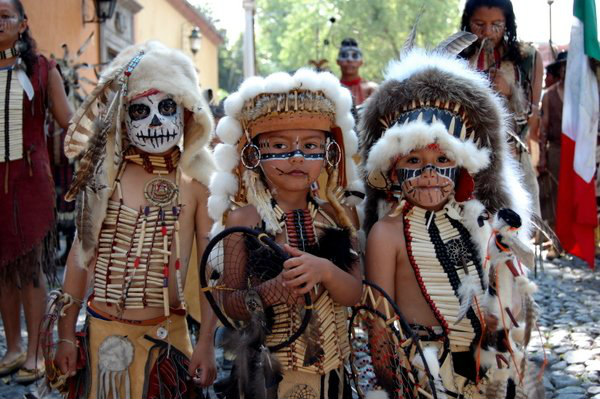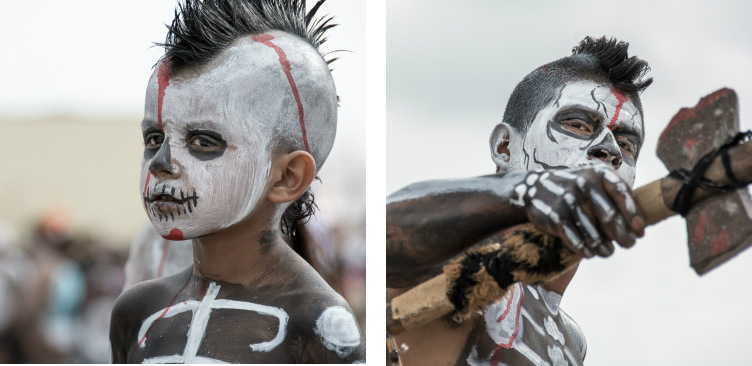
by Joseph Toone
As a child, May marked the month of Mary and being oh so close to summer vacation, assuming June wasn’t going to be spent making up for those no longer appreciated snow days off school. Here in San Miguel May means something completely different with a month-long celebration of the cross both in and around town.
In September 1531 Chichimecas (indigenous hunter gathers) fought the newly arrived Spanish military in the Lejona. La Lejona is an area between today’s La Comer and the neighboring mountain top village behind it called Puerto de Calderon (then called Door of Barbarians). Between the two sides, in what became known as the Battle of Barbarians, neither side gained an upper hand in the battles. Then a splendid cross appeared in the sky causing the fighting to stop among yells of “He is God!”

If you were a Catholic Spaniard, it was obvious to you that God was on your side. I mean, it’s a cross! But then, so too, from the indigenous mindset, the cross was meant for them.
For the indigenous any intersection of two lines implied the meeting of male and female, or the Divine. The cross contained indigenous symbolism like the sun, moon and conch shell dancers.
Even more obvious symbolic to the indigenous was the body of Jesus, that was represented by his feet, hands, heart and head. The indigenous were use to going to battle to collect prisoners of war, whose hands and feet were eaten by the highest local leader. An emperor (like Montezuma) or high priest consumed the head and heart. Indigenous believed in human sacrifices, like Jesus’, to appease a god.
The style of inserting Christ’s head, heart, feet and/or hands within the material of a cross became common among the Otomis (indigenous farmers) of San Miguel and is seen throughout town still as on the bridge to the Fabrica de la Aurora.

The cross in the sky appeared on September 29th, the feast day of St. Michael the Archangel, forever labeling our area as San Miguel, first, San Miguel de los Chichimecas, today, San Miguel de Allende.
Following the cross’s appearance in the sky, a chapel was built in the area where the celestial cross appeared, already a sacred spot to indigenous for whom it marked the border of two ecosystems, with more rain on the Comonfort side of the mountain. Also the spot marked the geographic center of the Americas (north, south, east and west) being where souls entered the afterlife. The area for the indigenous was a hub of supernatural energy and a portal to contact ancestors.
The ancient chapel is a short distance off the highway via dirt road before you come to the new, large winery when leaving San Miguel de Allende towards Comonfort.

May third is the official day of reverence for the Holy Cross and the best day to visit this old chapel now cared for by Julia Aguilar (widow of Genaro Patlan de la Luz, the previous caretaker that died in 1993). Julia descended from indigenous that participated in the Battle of the Barbarians. On May third folks will line up all day to be blessed by Julia with the power of holy cross, rubbing a white candle over you and burning copal incense for your protection.
Julia is also a bit of chocoholic and will appreciate your gifts of homemade cookies and brownies to add to the fiesta flair of the day.
As the Spaniards built the present town of San Miguel they set aside el Centro for themselves (location, location, location) and placed wooden crosses in the four oldest neighborhoods to mark them off for the Chichimecas. If you were a Chichimeca at this time you realized this new god, made from wood, was a woosie, as wood burns. Real gods were made from stone.
Quickly the wood crosses were replaced by stone (replicas still visible today) and the law became that only stone crosses were to be in your home at the family altar, no other religious images. Clever Chichimecas hollowed out their stone crosses, put their little stone gods inside, and placed a fake front keeping both their gods, and the Spaniards, somewhat happy.
At this time began the painting of images on small metal surfaces representing personal stories of miracles and faith attributed to the holy cross. Called retablos, the paintings are highly coveted by folk art collectors and still in use at the chapel in Valle de Maiz.

During May the oldest neighborhoods (Guadiana, Ojo de Agua, La Palmita and Valle de Maiz) each have their own venerations of the cross and celebrations. The first Sunday of month is in Guadiana because it is the oldest area of San Miguel. The second Sunday is in Ojo de Agua, the third in La Palmita and the fourth Sunday is Valle De Maiz. There are other neighborhood celebrations venerating the cross including El Tecolote, El Chorro, El Charco and San Juan de Dios. The objective of the festivals is to give thanks for all the blessings received during the past year and pray for a good rainy season and harvest.
Venture farther afield on May 3rd and throughout the month of May to witness celebrations in the campos. Alcocer (behind the mall) starts the month with a grand cowboy/girl procession with folks bringing their crosses from home to the church of St. Nicholas for blessing. Basically head in any direction to any village and you’ll experience some of the prolific celebrations of the cross all month long.
But hurry back to town for the last week of May as Valle de Maiz is party central. Concerts, dancing, games, food and graphic reenactments of the Battle of Barbarians are enjoyed. Suffice to say the conquistadors don’t always defeat the Chichimecas!
**************

Joseph Toone is Amazon's bestselling author of the San Miguel de Allende Secrets series of books and TripAdvisor's best rated historical walking tour guide. For more information contact toone.joseph@yahoo.com or visit History and Culture Walking Tours or JosephTooneTours.com, also on FaceBook.
You must register and log in to write a comment.
Please use the "login" link at the top (right) of the page.
|